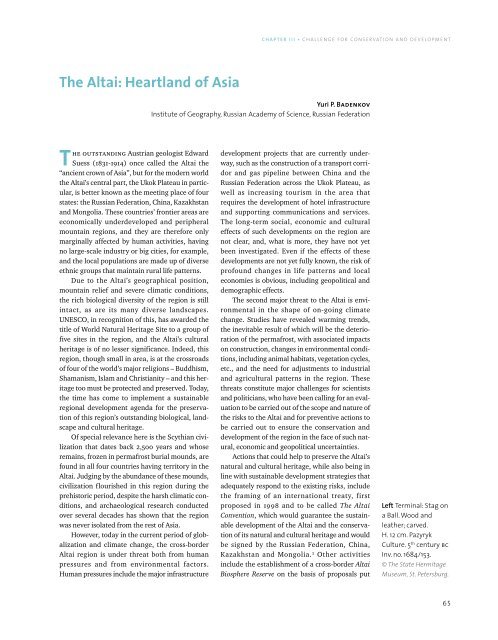Scythian Culture - Preservation of The Frozen Tombs of The Altai Mountains (UNESCO)
Create successful ePaper yourself
Turn your PDF publications into a flip-book with our unique Google optimized e-Paper software.
CHAPTER III • CHALLENGE FOR CONSERVATION AND DEVELOPMENT<br />
<strong>The</strong> <strong>Altai</strong>: Heartland <strong>of</strong> Asia<br />
Yuri P. Badenkov<br />
Institute <strong>of</strong> Geography, Russian Academy <strong>of</strong> Science, Russian Federation<br />
<strong>The</strong> outstanding Austrian geologist Edward<br />
Suess (1831-1914) once called the <strong>Altai</strong> the<br />
“ancient crown <strong>of</strong> Asia”, but for the modern world<br />
the <strong>Altai</strong>’s central part, the Ukok Plateau in particular,<br />
is better known as the meeting place <strong>of</strong> four<br />
states: the Russian Federation, China, Kazakhstan<br />
and Mongolia. <strong>The</strong>se countries’ frontier areas are<br />
economically underdeveloped and peripheral<br />
mountain regions, and they are therefore only<br />
marginally affected by human activities, having<br />
no large-scale industry or big cities, for example,<br />
and the local populations are made up <strong>of</strong> diverse<br />
ethnic groups that maintain rural life patterns.<br />
Due to the <strong>Altai</strong>’s geographical position,<br />
mountain relief and severe climatic conditions,<br />
the rich biological diversity <strong>of</strong> the region is still<br />
intact, as are its many diverse landscapes.<br />
<strong>UNESCO</strong>, in recognition <strong>of</strong> this, has awarded the<br />
title <strong>of</strong> World Natural Heritage Site to a group <strong>of</strong><br />
five sites in the region, and the <strong>Altai</strong>’s cultural<br />
heritage is <strong>of</strong> no lesser significance. Indeed, this<br />
region, though small in area, is at the crossroads<br />
<strong>of</strong> four <strong>of</strong> the world’s major religions – Buddhism,<br />
Shamanism, Islam and Christianity – and this heritage<br />
too must be protected and preserved. Today,<br />
the time has come to implement a sustainable<br />
regional development agenda for the preservation<br />
<strong>of</strong> this region’s outstanding biological, landscape<br />
and cultural heritage.<br />
Of special relevance here is the <strong>Scythian</strong> civilization<br />
that dates back 2,500 years and whose<br />
remains, frozen in permafrost burial mounds, are<br />
found in all four countries having territory in the<br />
<strong>Altai</strong>. Judging by the abundance <strong>of</strong> these mounds,<br />
civilization flourished in this region during the<br />
prehistoric period, despite the harsh climatic conditions,<br />
and archaeological research conducted<br />
over several decades has shown that the region<br />
was never isolated from the rest <strong>of</strong> Asia.<br />
However, today in the current period <strong>of</strong> globalization<br />
and climate change, the cross-border<br />
<strong>Altai</strong> region is under threat both from human<br />
pressures and from environmental factors.<br />
Human pressures include the major infrastructure<br />
development projects that are currently underway,<br />
such as the construction <strong>of</strong> a transport corridor<br />
and gas pipeline between China and the<br />
Russian Federation across the Ukok Plateau, as<br />
well as increasing tourism in the area that<br />
requires the development <strong>of</strong> hotel infrastructure<br />
and supporting communications and services.<br />
<strong>The</strong> long-term social, economic and cultural<br />
effects <strong>of</strong> such developments on the region are<br />
not clear, and, what is more, they have not yet<br />
been investigated. Even if the effects <strong>of</strong> these<br />
developments are not yet fully known, the risk <strong>of</strong><br />
pr<strong>of</strong>ound changes in life patterns and local<br />
economies is obvious, including geopolitical and<br />
demographic effects.<br />
<strong>The</strong> second major threat to the <strong>Altai</strong> is environmental<br />
in the shape <strong>of</strong> on-going climate<br />
change. Studies have revealed warming trends,<br />
the inevitable result <strong>of</strong> which will be the deterioration<br />
<strong>of</strong> the permafrost, with associated impacts<br />
on construction, changes in environmental conditions,<br />
including animal habitats, vegetation cycles,<br />
etc., and the need for adjustments to industrial<br />
and agricultural patterns in the region. <strong>The</strong>se<br />
threats constitute major challenges for scientists<br />
and politicians, who have been calling for an evaluation<br />
to be carried out <strong>of</strong> the scope and nature <strong>of</strong><br />
the risks to the <strong>Altai</strong> and for preventive actions to<br />
be carried out to ensure the conservation and<br />
development <strong>of</strong> the region in the face <strong>of</strong> such natural,<br />
economic and geopolitical uncertainties.<br />
Actions that could help to preserve the <strong>Altai</strong>’s<br />
natural and cultural heritage, while also being in<br />
line with sustainable development strategies that<br />
adequately respond to the existing risks, include<br />
the framing <strong>of</strong> an international treaty, first<br />
proposed in 1998 and to be called <strong>The</strong> <strong>Altai</strong><br />
Convention, which would guarantee the sustainable<br />
development <strong>of</strong> the <strong>Altai</strong> and the conservation<br />
<strong>of</strong> its natural and cultural heritage and would<br />
be signed by the Russian Federation, China,<br />
Kazakhstan and Mongolia. 1 Other activities<br />
include the establishment <strong>of</strong> a cross-border <strong>Altai</strong><br />
Biosphere Reserve on the basis <strong>of</strong> proposals put<br />
Left Terminal: Stag on<br />
a Ball. Wood and<br />
leather; carved.<br />
H. 12 cm. Pazyryk<br />
<strong>Culture</strong>. 5 th century bc<br />
Inv. no. 1684/153.<br />
© <strong>The</strong> State Hermitage<br />
Museum, St. Petersburg.<br />
65
















